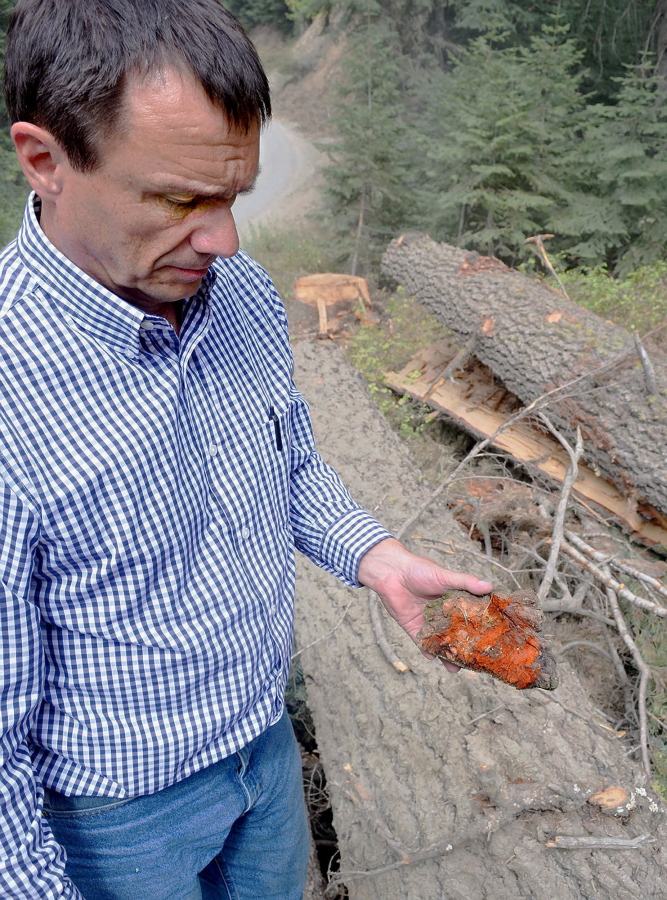BAKER CITY, Ore. — Nearly 400 acres of privately owned forest with Douglas and white fir, larch and ponderosa pine forest along Main and East Eagle creeks in northern Baker County is up for sale.
The U.S. Forest Service is interested in buying the land from the Collins Pine Company, a move that some county commissioners and other residents oppose, reported The Baker City Herald.
Paul Harlan, chief forester and vice president of resources for Collins Pine Company, calls the sale a redeployment of the family-owned company’s assets.
The 388 acres are part of three connected parcels along Main Eagle Creek and another close by near East Eagle Creek.
Although the market value is $228,060, according to the county assessor, Harlan says you can’t put a price on the intrinsic value of the property, which has two rustic cabins. From an economic standpoint, he said, there is not enough timber on the property to pay for its purchase price. Harlan said potential buyers need to keep that in mind.
“It’s a financial asset and not giving any financial value,” Harlan said. “But the intrinsic values of having over a mile of (Eagle Creek frontage) up there is incredible.”
Harlan said the company rarely sells land. The Eagle Creek sale would help the company rehabilitate 24,300 acres it owns near Lakeview that was burned in a wildfire in 2012.
If the Forest Service buys the Collins property, the agency intends to manage the land, which is surrounded by national forest, for recreational use as part of the Eagle Creek Wild and Scenic River Corridor, said Tom Montoya, supervisor of the Wallowa-Whitman National Forest.
Harlan said Collins Pine has been exploring the possibility of selling or trading the land to the Forest Service since the mid-1990s. In 2010 the company made the decision to sell.
“We would prefer the property stay in private hands and be managed sustainably,” Harlan said.
Collins Pine, which owns forests and mills in Oregon, California and Pennsylvania, bought the Eagle Creek acreage about 75 years ago when the company operated a sawmill in Pondosa, near Medical Springs.
Most of the Eagle Creek property was logged in 1991 with the goal of improving the forests’ health, Harlan said. This July about 150 acres was logged to salvage trees burned in the 12,763-acre Eagle Fire last summer.
The salvage operation yielded about 800,000 board feet of logs.
One goal of the 1991 harvest was to get rid of unhealthy trees and spur the growth of higher-quality trees.
During a tour of a portion of the Collins property and adjacent Forest Service land, both of which were spared from last year’s fire, the differences between the sites was evident.
On the Collins property there were fewer trees per acre, and less white fir, a tree susceptible to Indian paint fungus. The fungus attacks white fir and results in sections of the tree becoming unusable for lumber due to rot caused by the fungal infection.
Harlan pointed out several white firs on the Forest Service land that had one or more conks — the fruiting body of the fungus. In several minutes of searching only one white fir on the Collins property could be found with evidence of the infection.
“We took all that out 25 years ago,” Harlan said. “We wanted to keep the property healthy for future logging potential. You really can’t tell we were here.”
That is the eventual goal with the areas that were salvage logged in July.
Harlan pointed out several small white stumps located next to each other that showed the trees were afflicted by another fungus that causes root rot. Cutting those trees reduces the chance that the fungus will spread to nearby trees.
Getting rid of the white fir also has other purposes.
“It allows Douglas fir, (ponderosa) pine and larch to come in,” he said.
Those species provide a more marketable lumber with the latter two also being more resistant to fire compared to white fir.
Harlan pointed out various mature larch trees that could have been harvested but were left to seed the area.
In the areas that had been recently logged, Harlan used several stumps and slabs of wood to show how the forest’s health had improved since the 1991 harvest.
The proof was in a picture painted by growth rings exposed to the surface of the stumps.
Each ring indicates a year of growth. Those larger in width indicate a year of better growth. Counting back 25 rings (years) on most of the examples he pointed out, it was apparent that thinning the forest and opening it up resulted in up to a four- or five-fold increase in yearly growth.
“When you open up the forest, the trees left really take off,” Harlan said.
Harlan pointed out a larch estimated at about 200 years old. He had made sure it did not get harvested 25 years ago or in July when the area was salvage-logged.
The 200-year-old larch was in the path of a backfire lit during the 2015 Eagle fire. Firefighters had cleared the area around the old tree to keep it from catching on fire, but it still did. Fortunately they extinguished the flames, leaving the tree with a small burn scar at its base.
“If that (tree) could talk it could tell some stories,” Harlan said.



